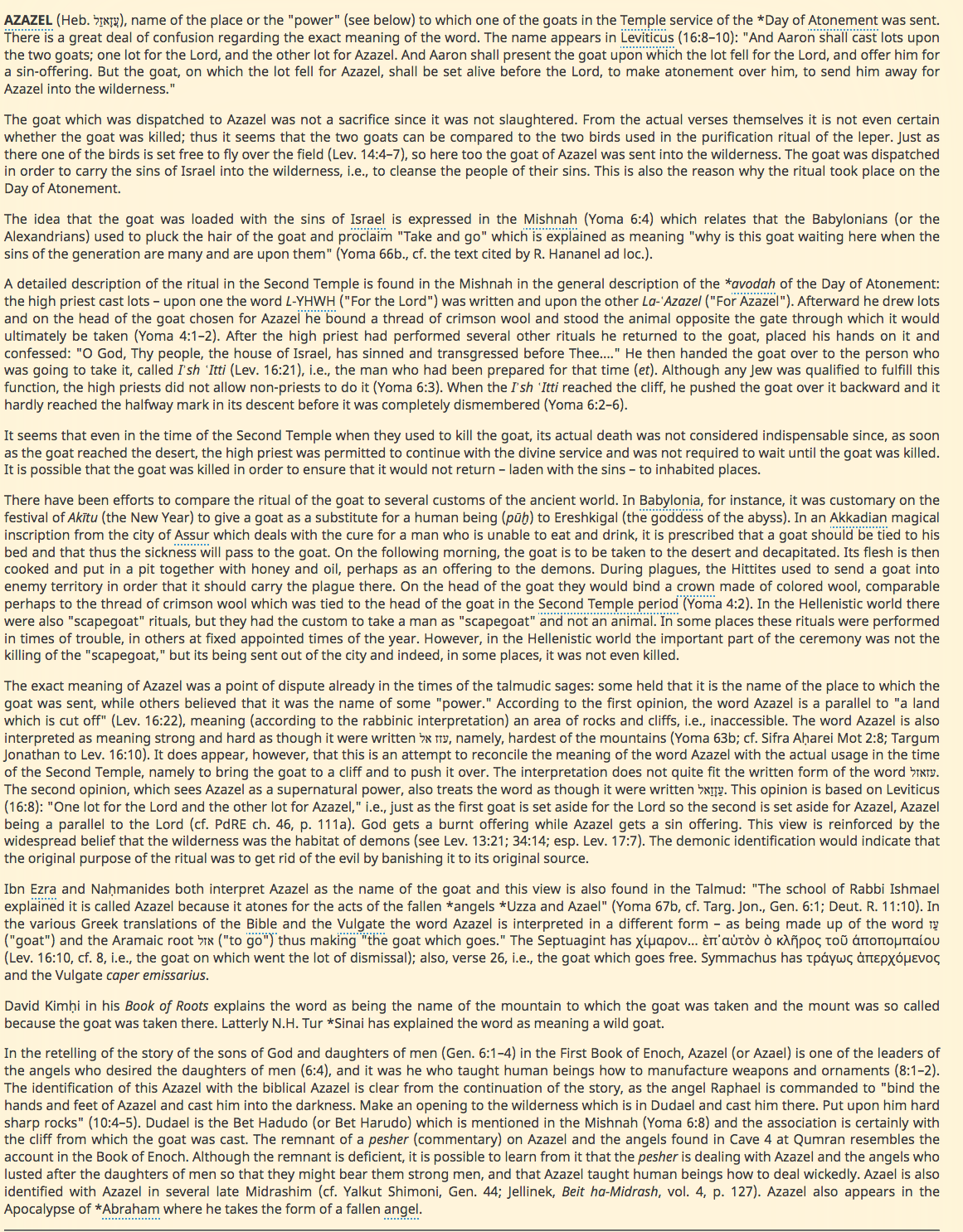Azazel/Iblis
In the story of Azazel, also known as Iblis, he is a fallen angel upon which the blame for the others falling is placed. This story is equivalent to the story of Lucifer’s fall, though his name is not mentioned. Azazel is known as the scapegoat and was, in one story, had the uncleanliness of the other angel’s actions put upon him and then sacrificed to restore the land. This story is similar to that of the Biblical Jesus and the sins of humans.
But, as in my story Gold ‘n Silver, the attempt to sacrifice another to heal or cleanse does not work.
Maimonides (1134–1204) says that as sins cannot be taken off one’s head and transferred elsewhere, the ritual is symbolic, enabling the penitent to discard his sins: “These ceremonies are of a symbolic character and serve to impress man with a certain idea and to lead him to repent, as if to say, ‘We have freed ourselves of our previous deeds, cast them behind our backs and removed them from us as far as possible’.”[16]
Other stories note that Azazel was not for giving humans knowledge or causing an angelic revolt but rather for having an affair with another angel named Uzza. Al-Uzza was also the name of a pre-Arabic triple-goddess.https://www.africansahara.org/evil-spirits-desert-azazel-djinn/
With Al-Uzza, we have the fusion of the goddess Al-Alat and then with Mullissu. Mullissu is seen as being the equivalent of Aphrodite. One of the variations of that name is Mulliltu, which is where the liltu (eventually lilitu and then Lilith) would be derived. Further connection of Uzza to Azazel is when the medieval scholar Nahmanides (1194–1270) identified the Hebrew text as also referring to a demon, and identified this “Azazel” with Samael.
Early reliefs of Lilith portray her with the feet of a Zu bird. the name AN.Zu can mean heavenly eagle. That is also the mythical bird that resides in Lilith’s tree in the Garden of Eden. Samuel Noah Kramer translated ki-sikil-lil-la-ke as Lilith in “Tablet XII” of the Epic of Gilgamesh. No one knows if that was her name. Some believe it refers to a water spirit. And if one reads the Angel Uzza’s name backwards, we see Azzu. And in the Assyrian Tree of Life, it is the winged god Assur/Ashur that is flying above the tree top.
Interestingly in some legends, the Anzu is depicted as a half-human and half-demon. It can also breathe fire and water. In one story he strips the father of the gods of the umsimi (“crown”), which brings us back to the concept of the cambion in both the hybrid, as well as the root word meaning “crown.” Some scholars believe this is creative power as opposed to an actual crown.
In another story the zu bird steals the prophetic tablets of fate, which confer ultimate power to the owner.
It is said that Ninurta (Cronus) or Marduk (equivalent Zeus or Apollo) killed the Zu bird and Lilith fled with Zu’s young. This is very much akin to the Grail legend of Mary Magdalene and the Knights Templar escaping with the offspring of the Biblical Jesus.
An alternative story has the father of Gilgamesh, Lugalbanda, killing the Zu bird. His queen, Ninsun, raises Gilgamesh and aids him in ruling the country. Both Lugalbanda and Ninsun are human. Her name means “wild cow” and “great queen.” This, of course, sounds quite a bit like the story of Egyptian Queen Hatshepsut.
And in my story, The Goddess Aped, it is a human who is following a goddess throughout all time to hunt her and her young into oblivion for their gifts. One can see how ancient man would perceive supernatural beings as having stolen their “abilities” since they have none. So once more there are supernatural beings being hunted/killed by humans due to jealousy. The picture below illustrates one of those hunts.

https://www.escholar.manchester.ac.uk/api/datastream?publicationPid=uk-ac-man-scw:1m1970&datastreamId=POST-PEER-REVIEW-PUBLISHERS-DOCUMENT.PDF

